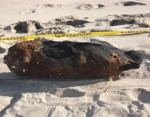Nelson Sigelman of the Martha’s Vineyard Times reported on the role VRHabilis played in the demolition of a rusted aerial bomb that washed up on a local beach:
Explosives ordnance disposal (EOD) experts Friday blew up a rusted aerial bomb that washed up on Wasque Point at the southeast corner of Martha’s Vineyard. The loud explosion that reverberated across Chappaquiddick contained echoes of an earlier era.
More than 60 years ago Navy and Army pilots regularly used Tisbury Great Pond and East Beach and an area known as Little Neck on Chappaquiddick for bombing and strafing practice. The list of munitions used at Tisbury Great Pond included 100- and 500-pound practice bombs with spotting charges and .30 and .50 caliber bullets.
Over the years the remnants of those training missions, rusted practice bombs, have continued to turn up in the marsh and on the beach, most often on areas owned or managed by The Trustees of Reservations (TTOR), the private conservation organization. Most of the ordnance are practice bombs that have only a small explosive charge, but a few of the discoveries have turned out to be the real thing.
Last September, federal, state, and Edgartown officials, along with TTOR representatives, established a plan to deal with unexploded bombs from the World War II era. Previously, the state police bomb squad was called to the Island to evaluate suspicious objects, but the frequent discoveries put a strain on the bomb squad’s resources. Now, when a bomb is discovered, the authorities notify West Tisbury resident Tom Rancich, a decorated 20-year veteran of the U.S. Navy who spent part of his career as a Navy Seal dealing with disposal of unexploded bombs.
Working under a contract with the Department of Environmental Protection. Mr. Rancich determines whether an object is safe to move and store, or whether it may be a live bomb that requires a controlled detonation.
Paul Schultz, assistant TTOR Chappaquiddick superintendent, discovered the bomb during a morning patrol Friday and notified Edgartown Police who then confirmed it was a bomb and contacted Mr. Rancich.
Chris Kennedy, TTOR southeast regional director, said the bomb found last week washed up almost exactly in the same spot where a similar bomb turned up last March. He suspects high winds on Thursday might have been responsible.
Mr. Kennedy said practice ordnance and some live bombs have washed up during the 20 years he has been on the job. He said there is no way of determining the danger and it is best never to assume there is no danger.
“From what I was told, they could not determine whether it was live or not so they did the safe thing and blew it up in place,” said Mr. Kennedy.
Mr. Rancich’s company, VRHabilis is under contract to investigate potential unexploded ordnance and provide training to the Trustees, lifeguards, police and other people who might come in contact with potential ordnance items. The State Police bomb squad and Navy EOD personnel from Newport have been called on to check on old window weights and other items that looked like ordnance but were not, said Mr. Rancich.
When he can conclusively determine that it is not ordnance or that it is safe to move, Mr. Rancich said he moves the item to a secure storage area for eventual recycling. If it is deemed unsafe to move, then the State police bomb squad and Navy EOD make a final determination and generally detonate the item.
Mr. Rancich said the criteria used to decide the safest course of action includes the ability to determine the identity of an object, its location and the likely hazard to the public. Generally speaking, he said it is unlikely that this type of bomb in that condition would explode “without a lot of help,” but, given the amount and variety of ordnance dropped and dumped during WWII, “it is best to assume the worst.”
As for what private citizens should do if they come upon a suspicious looking object on the beach, Mr. Rancich said, “We promote the program Recognize, Retreat, Report. Recognize that the item could be ordnance, retreat from the item the way you approached it, and report it to the police.”
View the full article online. More information on the ordnance cleanup at Martha’s Vineyard can be found in the following presentations (in PDF format): Martha’s Vineyard Ordnance and Interim Community Assistance: Martha’s Vineyard Ordnance Site.

